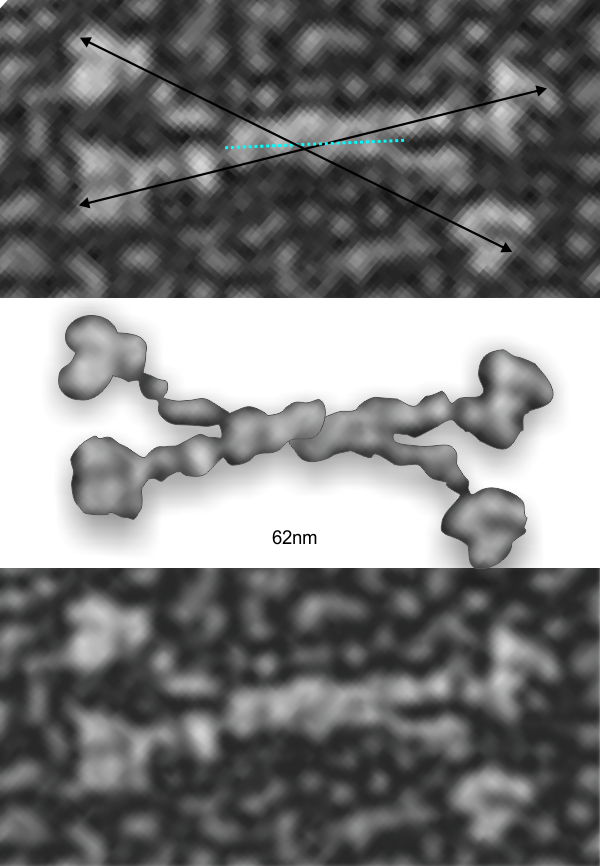Mini SP-D Ntermin and arm length and angle are quite close to measurements shown for images of SP-D by numerous authors. This little SP-D dodecamer image is from a publication by White et al, J Immunol 2008 and is described as having C3 and C4 of the collagen-like domain removed (these would be equivalent to the two lateral inbetween peaks that show up on LUT tables of AFM images of h and rSP-D and graphed a zillion times on this blog site.
In this case It is just noted that the central portion of the miniSP-D dodecamer is not that different from that of the full SP-D shown in other publications (rat mouse human). By the bar marker in this publication the rSP-D dodecamer is about 130nm from CRD to CRD on the opposite side. The miniSP-D is about 62nm from CRD to CRD on the opposite side, the center portion (the two N termini) of the mini-SP-D is about 22nm measured proportionally in reference to the estimated total width of the mini-dodecamer. This particular image is really interesting as well because if one looks closely at the “shadowing” and as i did, take the original 72ppi image and increase it to 600ppi then use a gaussian blur then the shading (shown below) is really beautiful and even demarks how the 2 N termini might come together side by side, rather than what I sort of guessed would be end to end. Side to side N termini would explain a couple of things: 1) the width and height of N terminus peak in AFM images, and the presence of central “holes” in fuzzyballs (seeing as the side to side N termini binding would allow for V shaped association and then alignment in a circle or sphere with a cantral cavity.
In addition the arm angle of rSP-D (unmodified) is about 48o and is really close to the angle measured in the 10 shadowed images for miniSP-D shown in White, et al’s publication (see image just below).
Add to that a cutout of an image with greater pixel density and a line drawing of two potentially Nterminus to Nterminus in side attachement, and the shading (not mine or photoshopped shading but actual shading from the original micrograph) in clarity the 3 CRD at the ends of the mini SP-D trimers (all four arms and their 12 heads), the thin adjacent peak (as lightness close to 100% or lumance close to 250) which is probably C1 portion of the collagen like domain, and perhaps C2, and the absence of the stretch of C3 and C4 as predicted in the publication by White et al listed above. It would be great to have some AFM images, though this shadowed image is really nice.  it might just be chance (maybe it is likely just chance) that the shadowing looks 3D and this is based upon the fact thta the shadoe cast images for SP-D (full size) in the same paper just does not show the detail that is seen with AFM…. it does show other detail better however (like arm width).
it might just be chance (maybe it is likely just chance) that the shadowing looks 3D and this is based upon the fact thta the shadoe cast images for SP-D (full size) in the same paper just does not show the detail that is seen with AFM…. it does show other detail better however (like arm width).
